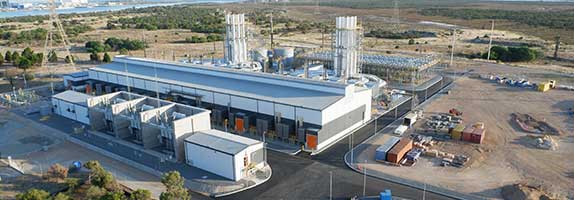

About Marine
Technology group Wärtsilä is calling for urgent action to enable more flexibility in power systems in Australia, as we reach a crucial renewable energy tipping point.
According to the Australian Energy Market Operator (AEMO) the amount of grid scale solar and wind in the Australian National Electricity Market (NEM) is set to triple by 2030. At the same time, retirements of coal-fired generators are expected to accelerate, with forecasts showing 46% of coal capacity exiting by 2030, equating up to 36% of total generation in 20231.
At COP28, the United Nations Framework Convention on Climate Change (UNFCCC) agreed to transition away from fossil fuels and triple renewable power by 2030, highlighting the urgency of the transition.
Renewable energy will become the world’s largest electricity source by 20252, and it is vital that flexible technologies are deployed at scale and pace to support that transition to avoid widespread curtailment, excessive prices, power instabilities, and higher emissions.
Frederic Carron, Vice President, Middle East & Asia, Wärtsilä Energy, says: “We stand at a tipping point, with unprecedented levels of renewables being added in Australia over the next decade and huge volumes of traditional inflexible assets on the cusp of retirement.
"Over the past decade we have transitioned from renewables requiring financial support, to a position where inflexible assets, such as coal, CCGTs (combined-cycle gas turbines) and nuclear are no longer viable without political support.
“This presents us with a unique opportunity: to add more renewable energy than ever before on to our grids, build the right level and right type of flexibility into our power systems and phase out inflexible assets while converting to sustainable fuels. Ultimately this will ensure a transition that fully phases out fossil fuels and is affordable, low carbon and resilient.
“The decisions that we make today in designing our power systems will echo for generations, as we aim to tackle climate change and embed the right technologies to accelerate the deployment of renewables.”
To ensure we address this tipping point, Wärtsilä is calling on policy and decision makers around the world to:
Choosing the right technology
According to IEA World Energy Outlook report, gas generation will increase 1% by 2030 and decrease 5% by 2050 (TWh) 3, however global utilisation and the emissions from the sector will drop significantly, as we reach an additional energy tipping point. Gas will increasingly shift from providing baseload power to providing flexible and firm capacity for real-time and seasonal renewable balancing.
However, not all flexible generating assets are created equal. Wind and solar power are intermittent, so flexible assets are required to manage minute-level, daily and seasonal variations in renewable generation, to ensure the lowest carbon and most cost-effective power systems.
Engines are the optimal flexible power generation technology choice over aeroderivative gas turbines in a five-minute market, as they:
Frederic Carron continued:"Grid balancing engines will play a vital role in supporting high renewable power systems, as they are the most efficient power generation technology to support intermittent wind and solar. In the future they can run on sustainable fuels, like hydrogen, to create 100% renewable power so there is no chance of stranded assets. Fuel flexibility and fast response are vital ingredients for ensuring a dependable source of electricity.
“We have all the technologies required to achieve net zero. It is essential that the correct incentives and policies are put in place today, to enable the deployment of flexible technologies and keep costs and emissions low, while shaping the power systems of tomorrow.”
Media contact:
Emma Tallgren
General Manager, Marketing & Communications, Middle East & Asia
Wärtsilä Energy
Mob: +358 40 1740130
emma.tallgren@wartsila.com
All Wärtsilä releases are available at www.wartsila.com/media/news-releases and at news.cision.com/wartsila-corporation where also the images can be downloaded. Use of the image(s) is allowed only in connection with the contents of this press release. Wärtsilä images are available at www.wartsila.com/media/image-bank.
Wärtsilä Energy in brief
Wärtsilä Energy leads the transition towards a 100% renewable energy future. We help our partners to accelerate their decarbonisation journeys through our market-leading technologies and power system modelling expertise. These cover decarbonisation services, future-fuel enabled balancing power plants, hybrid solutions, energy storage and optimisation technology, including the GEMS Digital Energy Platform. Wärtsilä Energy’s lifecycle services are designed to increase efficiency, promote reliability and guarantee operational performance. Our track record comprises 79 GW of power plant capacity and 125 energy storage systems delivered to 180 countries around the world.
www.wartsila.com/energy
Wärtsilä in brief
Wärtsilä is a global leader in innovative technologies and lifecycle solutions for the marine and energy markets. We emphasise innovation in sustainable technology and services to help our customers continuously improve environmental and economic performance. Our dedicated and passionate team of 17,800 professionals in more than 280 locations in 79 countries shape the decarbonisation transformation of our industries across the globe. In 2023, Wärtsilä’s net sales totalled EUR 6.0 billion. Wärtsilä is listed on Nasdaq Helsinki.
www.wartsila.com
Please contact us for any further information you may require on our company.
Wärtsilä Australia Pty Ltd.
48 Huntingwood Drive
Huntingwood NSW 2148
Tel: +61 2 9672 8200
Fax: +61 2 9672 8585